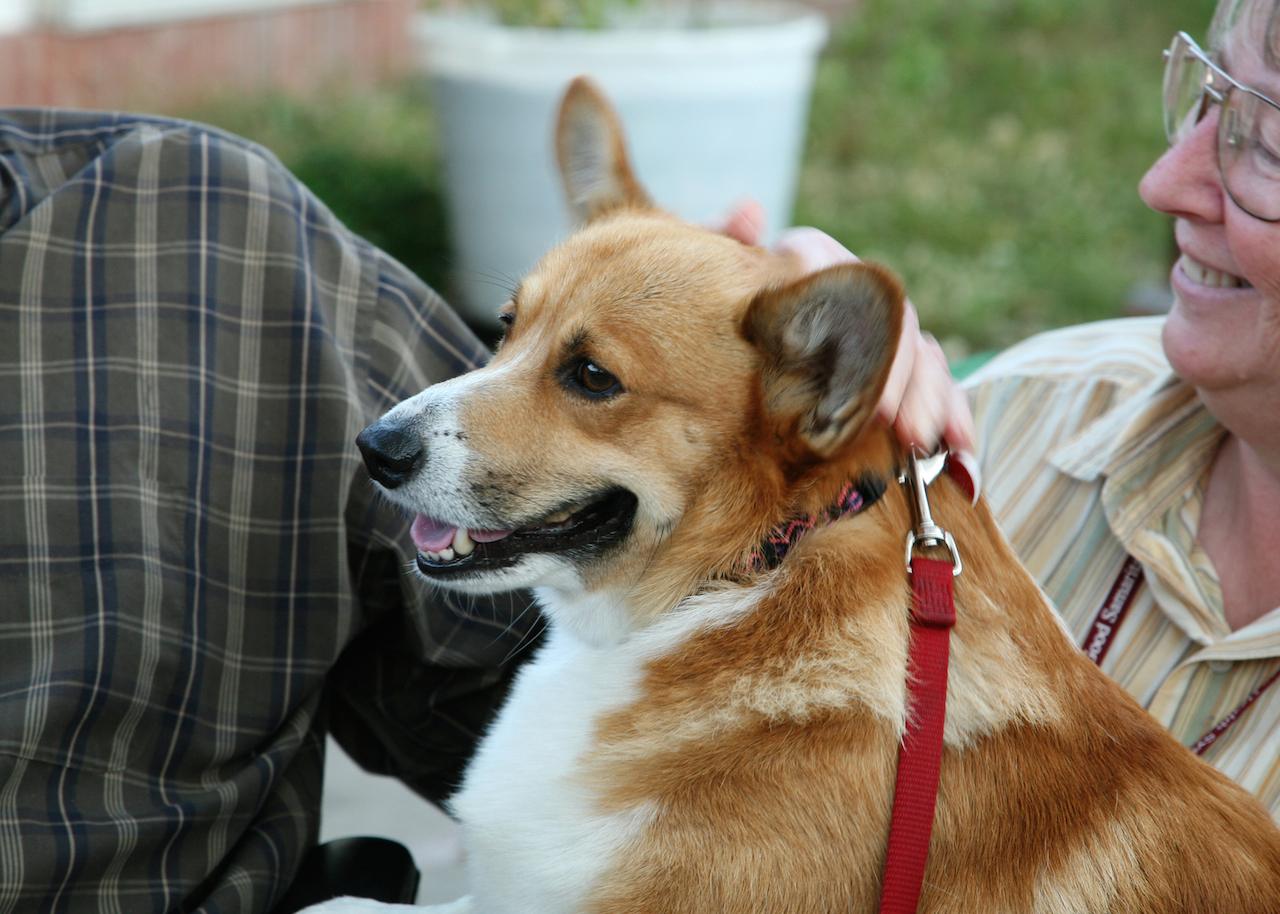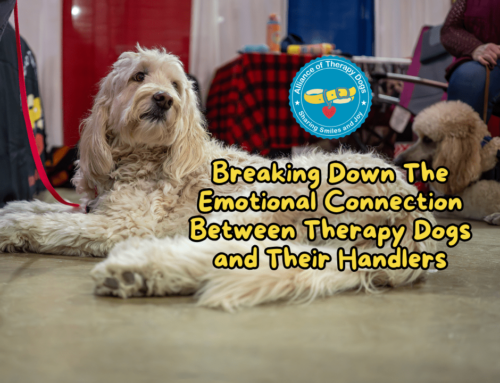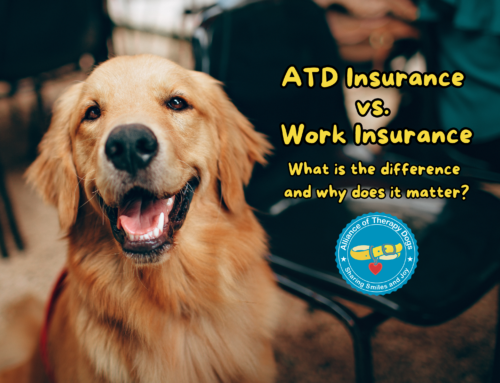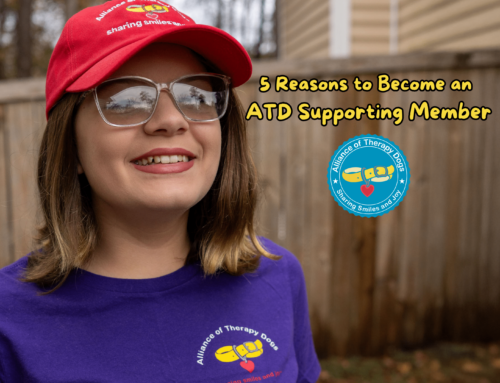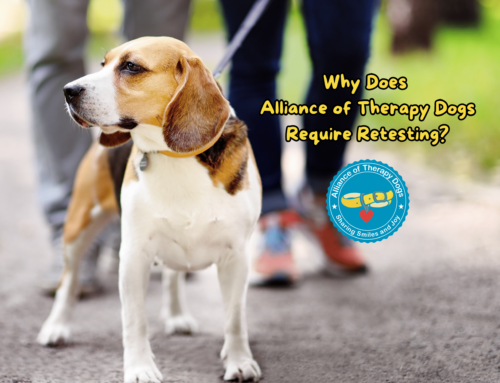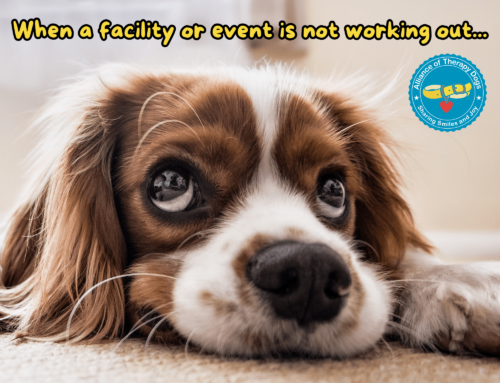How To Advocate For Your Dog
As therapy dog handlers, our canine team members play an essential role in sharing smiles and joy. Though amongst the comfort and support therapy dogs provide, it’s important to focus on their safety as well. Follow our strategies to advocate for your dog to help create a safe and positive environment on therapy dog visits.
Therapy Dog Visit Tips
- Encourage others to avoid getting too close to your dog’s face. Advocate for your therapy dog by informing people that we cannot allow our dogs to deliver kisses while on visits. You can help enforce this rule by placing a guiding hand beneath your dog’s chin or two fingers inside the dog’s collar. Setting your dog up for success by proper positioning can result in a successful therapy dog visit.
- Do not ask your dog to tolerate poor human behavior! Watch your dog’s body language. If you notice they look afraid or nervous, give them a break. Excuse yourself and your dog from the situation if the therapy dog visit becomes negative or questionable.
- If the person you are visiting does not want to pet your dog, try a different approach. For instance, you can ask if the person wants to see your dog perform a trick. In most cases, they will respond with yes and be content watching your dog spin, dance, or even enjoy basic obedience. This way, you’re advocating for your dog while also ensuring everyone’s comfort and safety.
- If someone speaks to your dog in an excited and high-pitched tone, they may become overly excited. You can either call your dog’s name to draw them to you or respectfully advocate for your dog by saying, “I don’t want them to jump on you, would you mind talking a little quieter?” You might also mention that jumping is not permitted per Alliance of Therapy Dogs rules and regulations.
It’s essential to be proactive and focus on safety during therapy dog visits. Even though Alliance of Therapy Dogs does provide liability insurance while you and your dog are on a volunteer therapy dog visit, the safety of our teams and those we visit must be a priority.
Team Photos
If you choose to take a team photo while on a therapy dog visit with other Alliance of Therapy Dog handlers and their dog, keep in mind your dog’s comfort and ATD rules. We require two feet or more of space between dogs. Leashes must be visibly held. Advocate for your dog if they are distracted or uncomfortable near another team. Ask for more feet of space if needed.
Know Your Therapy Dog
You know your dog best. You know their behavior and quirks.
- In our Advocating for Your Therapy Dog webinar, we offer an example of a large dog who enjoys sitting in people’s laps, especially those who may be sitting on the floor. On therapy dog visits, the handler will prevent that behavior by shifting her dog so that it is standing sideways to the individual and less likely to snuggle in their laps.
- If you notice your dog is tired, stressed or ready to go home, you should end the visit early. Yes, some people may be sad that they didn’t get to pet your dog, but if you stay too long and an incident occurs, it could put a potential halt to you and your dog’s therapy dog journey.
- If your dog is a high-energy breed, you may want to take them for a long walk or run before a therapy dog visit with some of their energy burnt off to prevent them from getting overexcited.
Control Your Dog’s Head
Our dogs sometimes love to go in headfirst, but that can be startling for children or people who aren’t used to dogs. On the other hand, people can also make unexpected movements and stick their faces into your dog’s face. You can advocate for your pup by having one hand on your dog’s collar and one hand under its chin to control its head. Positioning the dog’s body perpendicular or to the side of the person you visit, helps to control face-to-face encounters. It’s important to be watchful of your dog and aware of the situation you are currently engaging in.
Advocate For Small Dogs
Placing your small therapy dog in a stranger’s lap who needs cheering up may feel consoling. However, not all small dogs are comfortable being held by others or you may feel it isn’t the right person to hold your dog. Advocate for your dog and let the individual know that your dog does not want to be picked up or cuddled now. If you are comfortable with handing your small dog over to another person, keep a hand on your dog to guide the transition, and your hand should still be on the dog when they are in another person’s lap.
Crowded Areas
If you volunteer in a crowded area like an airport, you know how busy it can get. If you sense your dog is feeling overwhelmed by the amount of people, you can back them away from larger crowds and give them a break. In the webinar, we also suggest advocating for your dog by saying, “I think my dog has to go to the bathroom.” Most people won’t argue with this and will understand that your dog needs to leave. Even if your dog doesn’t have to go to the bathroom, this can be a good line to help keep your dog safe from overcrowding. If your dog isn’t comfortable at airports, you can find another venue where both you and your dog will be comfortable.
Advocate At a Facility Level
If you visit the same facility often, you can let them know our rules and regulations such as, “no jumping” and “dogs over fifty pounds can not be placed on the bed.” You can also ask the facility to display signs or educate staff about the rules during therapy dog visits. Advocating for your dog means keeping you, the dog, the visitor, and the facility safe.
Advocating for your therapy dog is an important part of our role as handlers. It enhances the impact of our work and helps promote a safe therapy dog visit. If you have any questions concerning specific issues or how to manage them, please contact the ATD Office for help.
For more information, watch our webinar.

